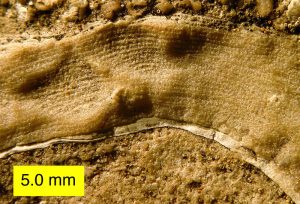The Wikipedia page on sponges is information-rich and accurate on our porous sponge friends. If you really want to get serious about sponges, visit the dull webpage of the International Association for the Study of Fossil Cnidaria and Porifera. There are a few nice images of fossil sponges on the Natural History Museum (London) website. Berkeley probably has the most comprehensive webpages on sponge ecology and evolution. The oldest known fossil sponge is a recently discovered specimen from the Ediacaran of China. It is super tiny.
Here’s a sad story on the last of the Greek sponge fishermen. Pollution, climate change and over-fishing have done in an industry thousands of years old.
Want to cheer up with a few movies of sponges? Of course you do! Watch a sponge feed, for example. The plots are a little thin, but the scenery is magnificent. And everyone must see the sponge final countdown. Oh yes, you must! Twenty-eight million viewers can’t be wrong.

Stromatoporoid in side view showing pillars and laminae. Columbus Limestone (Devonian of Ohio).
Geology in the News –
The headline of this story is odd (“Dinosaur DNA clues unpicked by researchers at University of Kent“. What does “unpicked” mean?), but the story is interesting. It is an attempt to describe non-avian dinosaur diversity by estimating what their genome looked like. Birds (which are dinosaurs) are used for the calculations.
A cool new fossil turtle was recently found in China. It is not surprising that it lacks a shell; it is the preservation that is remarkable. It is 228 million years old. What geological time period is this?
Check out this frozen horse 30,000 years old! It is an extinct Lenskaya horse found in melting permafrost in Siberia. Check out the details preserved. I imagine DNA could be easily extracted from the carcass.
